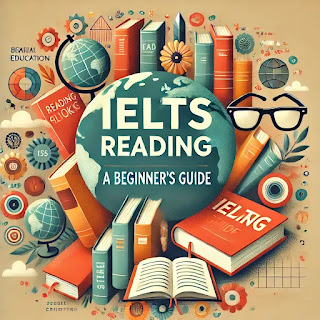The
International English Language Testing System (IELTS) is a standardized test
designed to assess English language proficiency for study, work, or migration
purposes. The Writing section, in particular, is often considered the most
challenging by beginners. However, with the right strategies and consistent
practice, you can excel in this section. This article provides a
beginner-friendly guide to help you navigate the IELTS Writing test and achieve
your desired band score.
Understanding the IELTS Writing Section
The
IELTS Writing test is divided into two tasks:
- Task 1:
- Academic Test: You are required to describe, summarize, or explain
information presented in graphs, charts, tables, or diagrams.
- General Training Test: You will write a letter (formal, semi-formal, or
informal) based on a given situation.
- Task 2: This is an essay-writing task where you respond to a
point of view, argument, or problem. It is the same for both the Academic
and General Training tests.
Key Features of the IELTS Writing Test
- Time Duration: 60 minutes (20 minutes for Task 1 and 40 minutes for
Task 2).
- Word Limit: At least 150 words for Task 1 and 250 words for Task
2.
- Scoring Criteria: Writing tasks are assessed based on four criteria:
- Task Achievement/Response: How well you address the task.
- Coherence and Cohesion: How logically and fluently you organize your ideas.
- Lexical Resource: Your vocabulary range and accuracy.
- Grammatical Range and Accuracy: Correct use of grammar and sentence structures.
Step-by-Step Guide for Beginners
1. Understand the Test Format
Begin
by familiarizing yourself with the test structure. Knowing what to expect will
reduce anxiety and help you plan your time effectively during the exam.
2. Focus on Time Management
Many
beginners struggle with time constraints. To overcome this:
- Allocate specific time slots
for each task: 20 minutes for Task 1 and 40 minutes for Task 2.
- Dedicate the last few minutes
of each task to proofreading.
3. Practice Basic Grammar and Vocabulary
For
beginners, building a solid foundation in English grammar and vocabulary is
essential. Pay attention to:
- Sentence Structures: Practice simple, compound, and complex sentences.
- Tenses: Ensure consistent use of past, present, and future
tenses.
- Linking Words: Use connectors like however, moreover, therefore,
and in contrast to improve coherence.
4. Learn Task-Specific Strategies
Task
1 (Academic):
- Analyze the Question: Identify key trends, comparisons, and significant
data points.
- Structure Your Answer:
- Introduction: Paraphrase the
question.
- Overview: Summarize the main
trends or features.
- Body Paragraphs: Provide
detailed explanations of the data.
- Avoid interpreting the data or
giving personal opinions.
Task
1 (General Training):
- Understand the Tone: Determine if the letter is formal, semi-formal, or
informal.
- Structure Your Letter:
- Salutation and Opening:
Address the recipient appropriately.
- Main Body: Cover all bullet
points in the task prompt.
- Closing: Use an appropriate
sign-off.
Task
2:
- Understand the Question Types: These may include opinion essays, discussion essays,
advantage/disadvantage essays, or problem/solution essays.
- Plan Before Writing: Spend 5-10 minutes brainstorming and outlining your
essay.
- Structure Your Essay:
- Introduction: Clearly state
your position or overview.
- Body Paragraphs: Present
well-supported arguments or ideas.
- Conclusion: Summarize your
main points.
5. Avoid Common Mistakes
- Word Count: Ensure your answers meet the word count requirement.
Short answers may lead to penalties.
- Spelling Errors: Practice spelling frequently used academic words.
- Repetition: Avoid overusing certain words or phrases. Instead,
use synonyms or alternative expressions.
Practice Techniques for IELTS Writing Beginners
1. Use Sample Questions
Practice
with official IELTS writing prompts to understand the question types and
improve your response skills.
2. Write Regularly
Set
aside time daily to write essays and descriptions. The more you practice, the
more confident you’ll become.
3. Get Feedback
Ask
a teacher, tutor, or friend proficient in English to review your writing and
provide constructive feedback.
4. Read and Analyze
Read
sample answers to understand what a high-scoring response looks like. Pay
attention to their structure, vocabulary, and ideas.
5. Improve Typing Speed (for Computer-Based IELTS)
If
you opt for the computer-based test, practice typing to avoid time wastage
during the exam.
Resources for Beginners
1. Online Platforms and Apps
Platforms
like IELTS.org, IELTS Liz, and the British Council website offer free
resources, practice questions, and tips.
2. Grammar and Vocabulary Tools
Apps
like Grammarly and Quizlet can help you improve grammar and expand your
vocabulary.
3. Mock Tests
Take
timed mock tests to simulate the actual exam environment and track your
progress.
Final Tips for Beginners
1. Stay Consistent
Progress
in IELTS Writing requires regular practice. Set a daily or weekly study
schedule and stick to it.
2. Stay Positive
It's
normal to feel overwhelmed initially. Focus on incremental improvement and
celebrate small victories.
3. Know Your Strengths and Weaknesses
Identify
which areas you need to work on most—be it grammar, vocabulary, or time
management—and dedicate extra time to those.
4. Practice, Revise, Repeat
The
key to success in IELTS Writing is repetitive practice. Keep refining your
writing style, vocabulary, and grammar.
Conclusion
Achieving
a high score in the IELTS Writing test is attainable, even for beginners. By
understanding the test format, mastering essential strategies, and practicing
consistently, you can build the confidence and skills necessary to perform
well. Remember, preparation is the key to success. So, start your journey
today, and you’ll soon find yourself writing with ease and confidence.




